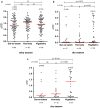Exploring the heterogeneity of human exposure to malaria vectors in an urban setting, Bouaké, Côte d'Ivoire, using an immuno-epidemiological biomarker
- PMID: 30857543
- PMCID: PMC6413440
- DOI: 10.1186/s12936-019-2696-z
Exploring the heterogeneity of human exposure to malaria vectors in an urban setting, Bouaké, Côte d'Ivoire, using an immuno-epidemiological biomarker
Abstract
Background: In some African cities, urban malaria is a threat to the health and welfare of city dwellers. To improve the control of the disease, it is critical to identify neighbourhoods where the risk of malaria transmission is the highest. This study aims to evaluate the heterogeneity of malaria transmission risk in one city (Bouaké) in a West African country (Côte d'Ivoire) that presents several levels of urbanization.
Methods: Two cross-sectional studies were conducted in three neighbourhoods (Dar-es-Salam, Kennedy and N'gattakro) in Bouaké during both the rainy and dry seasons. Data on insecticide-treated net (ITN) use and blood samples were collected from children aged between 6 months and 15 years to determine the parasite density and the prevalence of Plasmodium falciparum and the level of IgG against the Anopheles gSG6-P1 salivary peptide, used as the biomarker of Anopheles bite exposure.
Results: The specific IgG levels to the gSG6-P1 salivary peptide in the rainy season were significantly higher compared to the dry season in all neighbourhoods studied (all p < 0.001). Interestingly, these specific IgG levels did not differ between neighbourhoods during the rainy season, whereas significant differences in IgG level were observed in the dry season (p = 0.034). ITN use could be a major factor of variation in the specific IgG level. Nevertheless, no difference in specific IgG levels to the gSG6-P1 salivary peptide was observed between children who declared "always" versus "never" sleeping under an ITN in each neighbourhood. In addition, the prevalence of P. falciparum in the whole population and immune responders was significantly different between neighbourhoods in each season (p < 0.0001).
Conclusion: This study highlights the high risk of malaria exposure in African urban settings and the high heterogeneity of child exposure to the Anopheles vector between neighbourhoods in the same city. The Anopheles gSG6-P1 salivary peptide could be a suitable biomarker to accurately and quantitatively assess the risk of malaria transmission in urban areas.
Keywords: Anopheles; Transmission risk; Urban malaria, salivary biomarker of exposure.
Figures


Similar articles
-
Anopheles salivary antigens as serological biomarkers of vector exposure and malaria transmission: A systematic review with multilevel modelling.Elife. 2021 Dec 23;10:e73080. doi: 10.7554/eLife.73080. Elife. 2021. PMID: 34939933 Free PMC article.
-
Evaluation of Malaria Urban Risk Using an Immuno-Epidemiological Biomarker of Human Exposure to Anopheles Bites.Am J Trop Med Hyg. 2018 May;98(5):1353-1359. doi: 10.4269/ajtmh.17-0231. Epub 2018 Mar 1. Am J Trop Med Hyg. 2018. PMID: 29512479 Free PMC article.
-
Plasmodium falciparum infection during dry season: IgG responses to Anopheles gambiae salivary gSG6-P1 peptide as sensitive biomarker for malaria risk in Northern Senegal.Malar J. 2013 Aug 30;12:301. doi: 10.1186/1475-2875-12-301. Malar J. 2013. PMID: 23988032 Free PMC article.
-
Preliminary validation of the use of IgG antibody response to Anopheles gSG6-p1 salivary peptide to assess human exposure to malaria vector bites in two endemic areas of Cameroon in Central Africa.PLoS One. 2020 Dec 31;15(12):e0242510. doi: 10.1371/journal.pone.0242510. eCollection 2020. PLoS One. 2020. PMID: 33382730 Free PMC article.
-
Human antibodies against Anopheles salivary proteins: emerging biomarkers of mosquito and malaria exposure.Trends Parasitol. 2025 May;41(5):361-373. doi: 10.1016/j.pt.2025.03.009. Epub 2025 Apr 16. Trends Parasitol. 2025. PMID: 40246632 Review.
Cited by
-
Hotspots and super-spreaders: Modelling fine-scale malaria parasite transmission using mosquito flight behaviour.PLoS Pathog. 2022 Jul 6;18(7):e1010622. doi: 10.1371/journal.ppat.1010622. eCollection 2022 Jul. PLoS Pathog. 2022. PMID: 35793345 Free PMC article.
-
Anopheles salivary antigens as serological biomarkers of vector exposure and malaria transmission: A systematic review with multilevel modelling.Elife. 2021 Dec 23;10:e73080. doi: 10.7554/eLife.73080. Elife. 2021. PMID: 34939933 Free PMC article.
-
IgG antibody responses to Anopheles gambiae gSG6-P1 salivary peptide are induced in human populations exposed to secondary malaria vectors in forest areas in Cameroon.PLoS One. 2022 Nov 10;17(11):e0276991. doi: 10.1371/journal.pone.0276991. eCollection 2022. PLoS One. 2022. PMID: 36355922 Free PMC article.
-
Two mosquito salivary antigens demonstrate promise as biomarkers of recent exposure to P. falciparum infected mosquito bites.medRxiv [Preprint]. 2024 Apr 22:2024.04.20.24305430. doi: 10.1101/2024.04.20.24305430. medRxiv. 2024. Update in: J Infect Dis. 2025 Mar 17;231(3):e570-e581. doi: 10.1093/infdis/jiae525. PMID: 38712295 Free PMC article. Updated. Preprint.
-
Pattern of antibody responses to Plasmodium falciparum antigens in individuals differentially exposed to Anopheles bites.Malar J. 2020 Feb 21;19(1):83. doi: 10.1186/s12936-020-03160-5. Malar J. 2020. PMID: 32085710 Free PMC article.
References
-
- Dossou-Yovo J, Doannio JMC, Diarrassouba S, Chauvancy G. Impact d’aménagements de rizières sur la transmission du paludisme dans la ville de Bouaké, Côte d’Ivoire. Bull Soc Path Exot. 1998;91:327–333. - PubMed
-
- Mouchet J, Carnevale P, Coosemans M, Julvez J, Manguin S, Richard-Lenoble D, et al. Biodiversité du paludisme dans le monde [Internet]. Paris: J. Libbey; 2004. http://www.documentation.ird.fr/hor/fdi:010035112. Accessed 24 Nov 2018.
MeSH terms
Substances
Grants and funding
LinkOut - more resources
Full Text Sources

